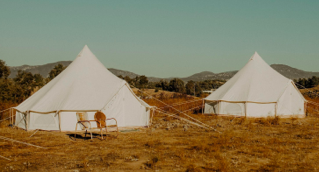LIVRAISON GRATUITE
Menu
-
- Boutique
- Tentes de camping
- Wall Tents
- Tente en toile
- Tentes cloches
- Tentes de festival
- Tentes de chasse
- Tentes Yourtes
- Tentes familiales
- Tente d'observation des étoiles
- Tentes cabanes
- Cadeaux de camping
- Tentes terrestres
- Poêles de tente
- Tente 4 personnes
- 6 Person Tents
- Tente 8 personnes
- 12 Person Tents
- Tente 6 personnes
- Équipement de camping
- Camping Chairs
- Shade Canopy Tents
- Camping Fans
- Prestations de service
- À propos
- Contact Us
- Reviews
-
- Connexion

Free Shipping

Pay No Sales Tax
30-Month Warranty
LIVRAISON GRATUITE
Tentes
À propos
Boutique


La liste LiT
Idées de glamping et de camping + ressources
How to Choose the Right Tent Stove
9 lire la lecture
Ready to add a tent stove to your canvas tent? Whether outfitting a hot tent for winter camping or simply adding ambiance to your glamping setup, choosing a tent stove is tough. The season, tent size, and type of firewood (and how seasoned it is) all play major roles in how a tent stove performs. So with all these variables, how does one decide?
Come along as we explain how to choose the right tent stove for your camp.
The Right Tent Stove Style For Your Tent

You’ll stumble across a few styles of tent stoves in your search. Glamping tent stoves, portable tent stoves, and even small or ultralight backpacker tent stoves boil down to two styles:
- Glamping Tent Stoves: This luxurious-style tent stove is more homey, substantial, and intended to stay put. Designed with many features you would find in a real wood stove at home (like a firebrick and baffle plate), they are ideal for stationary canvas tents and permanent four-season setups like your family deer camp – but they’re not super portable!
- Portable Tent Stoves: Portable tent stoves are a nice middle-ground alternative when you haul your camp gear and tent. Often designed with a barrel-shaped firebox with retractable, folding legs, these cylinder tent stoves are very fuel efficient and ideal for hot tent camping adventures.
Choosing the Right Tent Stove Size
Choosing the right tent stove size comes down to several factors, two major ones being how warm you need your tent (what season are you mostly using it) and the size of your tent (how many cubic feet you need to fill).
The seasons you plan to use a tent stove will matter a great deal. Breaking out a tent stove in spring or fall where it might dip cold during the evenings is an entirely different scenario than requiring and maintaining a consistent fire when camping in the dead of winter. Winter camping requires the right tent stove for more than comfort and ambiance. So you need an adequately sized tent stove (read: firebox).
Tent Cubic Feet to Firebox Sizes
As a good rule of thumb, the larger your canvas tent, the larger your tent stove should be. A small tent stove can warm a large tent, but it may not warm it efficiently or for hours on end. Instead, you’ll have to stoke and maintain it more often. However, you also don’t want a tent stove too large that could produce too much heat or smoke you out.
That’s not to say you can’t place a larger stove inside a small canvas tent. It may seem like overkill and a bit excessive, but it simply means you will have a warm tent for longer. Larger stoves with spacious boxes to hold more firewood can burn longer, which means a more efficient fire.
- Small Tents (sleeps 1-2)
- Volume of Tent: 400–800 cubic feet
- Firebox Capacity: 500–800 cubic inches
- Stove Weight: 10-20 pounds
- Medium Tents (sleeps 3-6)
- Volume of Tent: 800-1,500 cubic feet
- Firebox Capacity: 800-1,200 cubic inches
- Stove Weight: 20-30 pounds
- Large Tents (sleeps 7+)
- Volume of Tent: 1,500+ cubic feet
- Firebox Capacity: 1,200-2,000+ cubic inches
- Stove Weight: 30+ pounds
See the pattern? To heat your canvas tent sufficiently, your tent stove’s firebox should have roughly a cubic inch of space for each cubic foot of your tent.
For example, the Winnerwell Woodlander Double-View tent stove, which features a firebox capacity of roughly 1,500 cubic inches, is the right tent stove for 16’ and 20’ bell tents (taking into consideration the conical shape):
- 16’ Bell Tent | 9'8” center pole | 29.5” side walls = ~980 cubic feet
- 20’ Bell Tent | 11'4” center pole | 31” side walls = ~1,730 cubic feet
While it might seem a bit much for the 16’ bell tent, just remember that if you’re stuck between two sizes, always go bigger and keep the fire small.
Another tip to mention: Take into consideration how much space the tent stove will take up inside your tent. While the tent stove will hug a canvas wall (not the center), you still need to leave a safe perimeter to prevent fire hazards, along with a fireproof floor mat. So this might mean less space for a sleeping bag or camp gear.

Choosing the Right Tent Stove Weight & Portability
The weight and portability of your tent stove are important choices to make. Unless you have a hunting tent situated at a deer camp, or your tent pitched permanently on a platform, it’s safe to assume you’ll be toting that heavy stove back and forth and maybe miles into the wilderness every time you set up camp.
Weight and portability go hand-in-hand, often coming down to the metal in which the tent stove is built, which we will discuss in the next section. However, portability is also an important factor to consider.
The ideal scenario for a portable tent stove is one that offers collapsible legs and shelves, and stove flue pipe sections that can fit inside the stove firebox. Carrying bags help with transport and keep your tent stove protected between camping trips.
Metal Matters: The Right Tent Stove Materials
Consider the materials used as you choose the right tent stove for your canvas tent setup. More specifically, the metal used in the main frame and box. Because if you didn’t know by now: Not all metals are made the same and each has advantages and drawbacks in terms of performance, durability, and maintenance.
Here are the pros and cons of common metals used in tent stoves:
- Cast Iron Stoves: Just like your cast iron skillet or Dutch oven you use for campfire cooking, cast iron has a high heat retention. This means that a cast iron tent stove can keep a tent warm for a long time. The disadvantage? Also just like that skillet, it’s heavy as heck, and prone to rust when left exposed to moisture and acidic substances.
- Stainless Steel Stoves: Stainless steel is a great material for tent stoves. And while some lesser stainless steel metals can rust and corrode over time, you can find tent stoves made of quality 304 stainless steel. Stainless steel tent stoves are an excellent option for canvas tents, providing the perfect balance of weight, affordability, and durability.
- Titanium Stoves: Titanium tent stoves offer lightweight durability similar to titanium camp cookware, which makes them a nice option for backpacking or when you require the lightest tent stove possible. However, while titanium is considered a superior metal for tent stoves with its corrosion resistance and good heat conductivity, there is a catch. Titanium tent stoves are more difficult to repair and weld (in comparison to steel tent stoves).
- Aluminum Stoves: Aluminum tent stoves are the most affordable and lightest stoves you will find. However, while their cheap price tag may seem appealing – don’t be fooled! Aluminum tent stoves are not as durable as their metal alternatives and dent very easily. Aluminum is also not a great metal for heat retention – kinda the main point of a tent stove, right? – and will cool down rapidly.
Considering Your Budget
As you peruse or begin your hunt for the right tent stove, you’ll find a wide range of prices. You can find budget-friendly stoves on Amazon for less than $100, as well as quality tent stoves for over $1000.
But a word to the wise: like all well-made products you get what you pay for. Pay once, cry once, and then rest easy knowing your tent stove will keep your tent warm and last generations.
While you can find a range of costs for tent stoves, consider how much you are willing to spend. If you aim to settle somewhere in the mid-range price point, there are many excellent, affordable, and reliable models out there. With this guide at your fingertips and a little research to compare models, you can confidently choose the right tent stove.
For a great medium price point, we always recommend the Winnerwell Woodlander.
Tent Stove Features to Consider

The Main Firebox
As the main component of a tent stove, we’ve discussed the firebox a lot already. But here are some additional firebox features you could consider that are convenient touches to have.
- Firebox Door: A door with sealed gaskets offers a snug fit to prevent smoke escape. A well-made tent stove will rely on air intakes, vents, and other circulation controls instead.
- Door Window & Glass Viewing Areas: A tent stove will keep you toasty warm, but ambiance is your next goal, windows are essential. Glass viewing areas and windows made of heat-resistant ceramic or tempered glass offer safe fire monitoring too.
- Ceramic glass is found on cast iron stoves and is intended for higher temperatures up to 1470°F. The downside is ceramic is more brittle and prone to breaking on impact.
- Tempered glass will stand up to 470°F, which is perfectly adequate for most tent stoves. It’s also cost-effective and designed to shatter, not break, which adds a safety feature.
- Airwash Vent System: The best tent stoves will also feature an airwash system vent that draws air across the interior glass, keeping it clear of soot and ash for optimal viewing.
- Firewood Grate: Look for a raised metal grate inside your firebox to ensure airflow and an efficient burn. As wood burns, ashes fall through the grate to the bottom of the firebox, providing better air circulation. It also makes your firebox easy to clean out ashes, as needed, or to maintain your fire.
Tent Stove Chimney
Next to your firebox, your tent stove chimney is extremely important. The stove pipes ensure smoke safely rises up and out as it should, keeping both smoke and carbon monoxide outside the canvas tent. A portable-friendly tent stove will feature flue pipe sections that disassemble and conveniently pack away into the tent stove’s firebox.
- Pipe Damper: The pipe damper will help you control the airflow to the firebox, which makes maintaining your fire easy and safe. Not only will the pipe damper help maintain the tent stove’s heat, but it means a more efficient burn, meaning less firewood to haul.
- Stove Jack and Spark Arrestor: Your tent stove must have a stove jack and spark arrestor or spark guard. Otherwise, you are inviting the risk of a fire hazard, endangering yourself and bringing the potential of a forest fire. The stove jack will keep your canvas tent free of fire hazards, while the spark arrestor will catch any free-flying sparks or cinders that waft up the chimney. A rain cap can also keep the spark arrestor from clogging.
If your canvas tent lacks a stove jack, you can always add one. Here are step-by-step instructions for adding a stove jack to a canvas tent. (Even if you have another type of canvas tent, the steps are similar.)
Folding Legs or Raised Box
Many tent stove styles offer folding legs that tuck neatly under the firebox for better portability. However, you can also find tent stoves with an open box nook for storing firewood beneath. Either way, make sure your main heat source - the firebox – rests above the tent floor for optimal heat circulation and safety.
Water Heater Tank
A water heater tank is a wonderful addition for winter camping. Water heaters offer roughly 2 - 5 gallons of water, which you can heat for cooking or washing. However, these tanks are often accessories found on tent stoves with higher price points. So if you want to cut costs and just want to make coffee, you can simply place a kettle on a warming tray, sans water heater.
Warming Trays and Drying Racks
A warming tray can keep meals and coffee warm for a little while. Drying racks are practical for hanging winter clothes and gear out to dry.
A Note About Tent Stove Safety
After taking all that time and effort to research and choose the right tent stove, there’s one last step: learn tent stove safety practices.
Placing a tent stove in a canvas tent does come with hazards and dangers. Understanding how to prevent and handle those dangers will make a more worry-free, safe experience and camping excursion.
We won’t go into too much detail here, but some basics include:
- Choosing the right tent stove (and the right canvas tent with flame-retardant coating)
- Properly installing and ventilating your new tent stove
- Keeping a fire extinguisher on hand
- Knowing the signs of carbon monoxide and keeping a CO2 detector in the tent
- Performing routine tent stove maintenance
If you choose to outfit your canvas tent with a wood stove, you won’t regret it! But if you feel a tent stove simply isn’t right for your canvas tent setup – no sweat! There are other ways to heat a canvas tent.
Need Help Choosing the Right Hot Tent?
There are many benefits of camping with tent stoves, so if you love the idea, but are not sure what style canvas tent to buy, reach out to Life inTents, the glamping experts, to help you in your decision. We offer a wide range of bell tent sizes as well as wall tents to complete the perfect hot tent setup!
Related Resources

LA LISTE ÉCLAIRÉE 2 lire la lecture
Idées de camping dans la cour avec des enfants pendant le COVID-19
Le camping familial pendant le coronavirus peut être tout aussi une aventure que le camping dans l
LA LISTE ÉCLAIRÉE 4 lire la lecture
Can Glamping Businesses Survive a Recession?
Examining the Resilience of Luxury Camping Businesses Glamping, the luxurious cousin of traditional Blogues populaires
1. Qu’est-ce que le Glamping ?
2. Comment démarrer une entreprise de glamping
3. Créez une plate-forme de tente cloche
4. Les meilleures toilettes portables pour le camping
5. Comment installer et plier une tente cloche
6. Les meilleurs poêles de tente à cloche – Façons de chauffer une tente en toile
Produits populaires
S'abonner
Inscrivez-vous pour recevoir les dernières nouvelles sur les ventes, les nouveautés et les conseils
DEVENEZ UN INITIÉ
Nous partagerons périodiquement avec vous des idées, des sorties de tentes cloches, des offres spéciales et des notifications d'événements.


